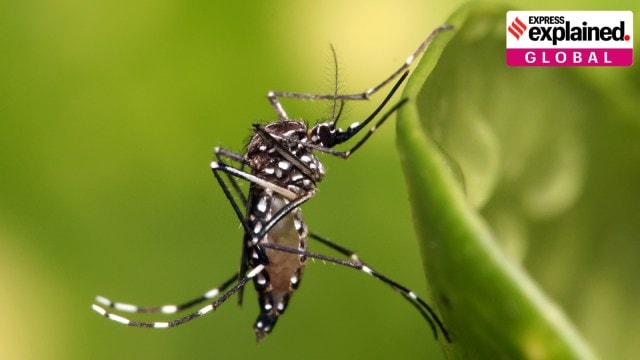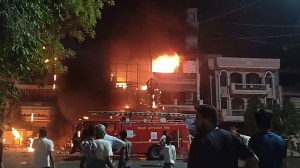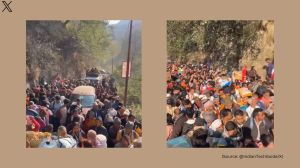- India
- International
What led to Latin America’s record dengue surge
While some countries are witnessing a surge in dengue much before the peak season, others are recording severe outbreaks for the first time. Here is a look at the situation
 Aedes aegypti mosquito which can spread dengue. (Wikimedia Commons)
Aedes aegypti mosquito which can spread dengue. (Wikimedia Commons)Cases of dengue in Latin America and the Caribbean are skyrocketing. Between January and April 2024, the region has seen more than 5.9 million cases compared to 4.4 million in all of 2023. While some countries are witnessing a surge in dengue much before the peak season, others are recording severe outbreaks for the first time.
Behind the uptick is the obvious reason: soaring global temperatures, which have created ideal conditions for mosquitoes — they spread dengue among people through bites — to thrive. To make matters worse, the world has yet to roll out a high-efficacy dengue vaccine that can thwart the spread at a large scale.
Although dengue fever’s fatality rate is quite low, in some cases it can lead to “breakdown fever”, which causes severe joint pain, haemorrhage and, sometimes, death.
Here is a look at how bad the situation is in Latin America and the Caribbean, what is the role of climate change, and how far efforts for developing a dengue vaccine have come.
What is happening?
Brazil is the worst affected country in the region. More than 4.2 million people have caught dengue in the country between the start of the year and April 23, which is around 1.8% of the population, according to Brazil’s health ministry. So far, more than 2,000 people have died due to the disease — a record of deaths by dengue fever in a single year.

Several of the country’s states (there are 26 in total) have declared a state of emergency. The army has set up field hospitals in the capital, Brasília, to accommodate patients, who could not get medical attention in hospitals. Mosquitoes repellents are sold out and it is not clear when the new stock will arrive, according to a report by The Economist.
Peru and Puerto Rico have also declared a state of emergency in response to a spike in cases of dengue fever. While Puerto Rico reported 549 cases by March-end (compared to 1,293 total cases in 2023), Peru has witnessed 1,35,000 suspected cases and 117 deaths between January and early April compared to 33 deaths in the same period last year. Argentina has recorded a huge spike in the number of cases as well.
Central American countries and Mexico, which usually see a rise in dengue cases towards the end of the year, are already witnessing a spread. The disease has also severely hit countries such as Uruguay and Chile, which have never been seriously affected.
“We already have a large number of cases this year, not only in Brazil but also Paraguay and Argentina and other countries — even Uruguay and areas where there has been no transmission of dengue for a century,” said Pan American Health Organization (another arm of the United Nations) director Jarbas Barbosa in a March press briefing.
Why is it happening?
The key driver behind the rising dengue cases is soaring temperatures. In the past 30 years, the region has warmed an average of 0.2 degree Celsius per decade, according to the State of the Climate in Latin America and the Caribbean 2022 report. This has not only led to more frequent and intense extreme weather events but also an increase in the mosquito population.
Most of the mosquito species thrive in warmer temperatures and with global warming the areas where they can breed and survive have increased, including in Latin America and the Caribbean. Higher temperatures have also extended the length of the season when mosquitoes are active, allowing a longer period for the transmission of vector-borne diseases.
“There are ever fewer places [in the region] where temperatures drop below 15 degree Celsius in winter, the level at which mosquitoes tend to die out, so there are more virus-carrying insects in circulation, ready to surge, once temperatures rise in the spring,” according to The Economist report.
The situation was exacerbated by the onset of the 2023 El Niño, a weather pattern that led to abnormal warming of surface waters in the equatorial Pacific Ocean, which increased temperatures even more across the region.
Extreme weather events have further multiplied the mosquito population. Untimely rainfall, storms, flooding, and rising sea levels create shallow, stagnant pools of water in which the bugs thrive. On the other hand, droughts lead people to collect and save water in containers that provide breeding places for mosquitoes.
Rapid urbanisation is another factor. “Latin America’s shantytowns are breeding grounds for mosquitoes because of the abundance of standing water, where the insects lay their eggs. Most houses have flat roofs, where water can make pools. Residents who lack basic plumbing often store water in open tanks. Patchy refuse-collection services leave piles of uncollected rubbish which also serve as a mosquito mecca,” The Economist report said.
What about dengue vaccines?
With the ongoing crisis in Latin America and the Caribbean, the need for a dengue vaccine is more urgent than ever. However, a viable dengue vaccine has not become a reality yet.
Dengue is spread when bitten by a female mosquito of Aedes genus and there are four strains of the dengue virus, which is a daunting challenge for scientists.
Speaking to The Indian Express, Virander S Chauhan, president of the Multi Vaccines Development Programme which is located at the International Centre for Genetic Engineering and Biotechnology (ICGEB) campus in New Delhi, said, “The issue is that if a vaccine protects you from one strain, you become more susceptible to other strains. The biggest challenge is to develop a vaccine which works against all the strains.”
Although scientists have created vaccines that protect against the four strains, they are either expensive or have serious limitations. For instance, Qdenga — a Japanese-made vaccine — costs about $115 per dose in Europe and $40 in Indonesia. Brazil, which has bought it for $19 per dose after negotiating a lower price for a large-scale purchase, is using it to vaccinate its population. However, there will be enough vaccines to fully vaccinate only 3.3 million of Brazil’s 220 million people in 2024, according to a report by The New York Times.
In February, Takeda Pharmaceuticals, which makes Qdenga, and Hyderabad-based vaccine maker Biological E announced that they have formed a strategic partnership to accelerate access to the vaccine. BE said it would produce up to 50 million doses a year. Experts believe that the deal could bring down the price of the vaccine, but BE is unlikely to get regulatory approval to market Qdenga before 2030, the NYT said.
Another vaccine is Dengvaxia, which is manufactured by Sanofi Pasteur, a French pharmaceutical company. Its biggest issue with this shot is that it can be given only to people who have already had a dengue infection.
Most recently, Brazilian researchers announced that a clinical trial of a new dengue vaccine had provided strong immunity against the disease. The vaccine, delivered in a single shot, has been created by the National Institutes of Health in the US and it uses live, weakened forms of all four strains of the dengue virus. The vaccine has been licensed for development by the Instituto Butantan, a public research institute in São Paulo, Brazil. Although it may transcend the limitations of its predecessors, it will not be rolled out at a national scale in Brazil for at least a couple of years, the NYT report said.
Serum Institute of India — the world’s biggest vaccine maker — is also testing a single-shot dengue vaccine based on the research of the NIH, according to a March Reuters report.
EXPRESS OPINION
May 26: Latest News
- 01
- 02
- 03
- 04
- 05







































